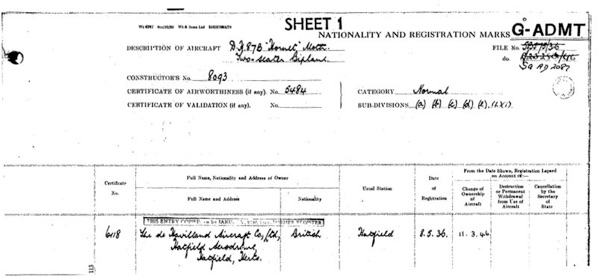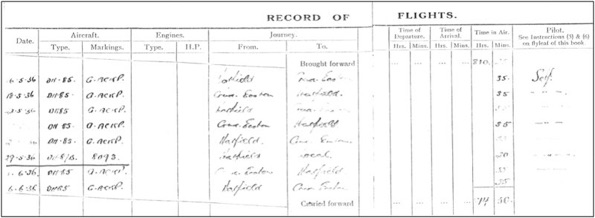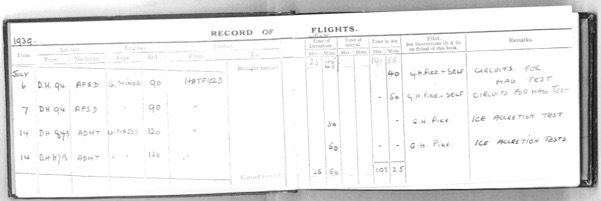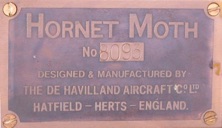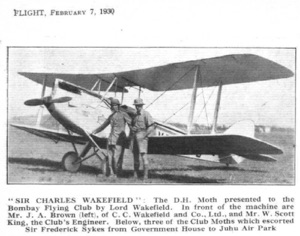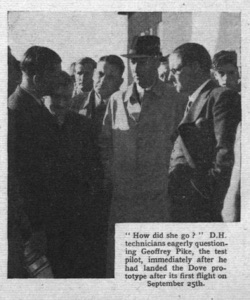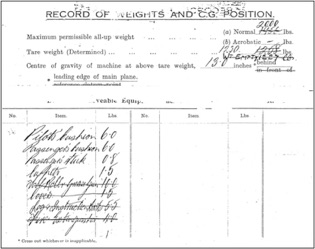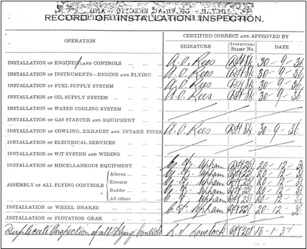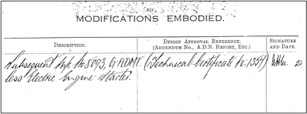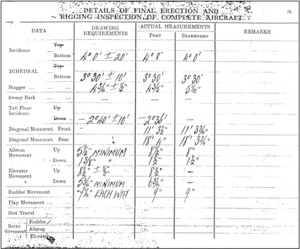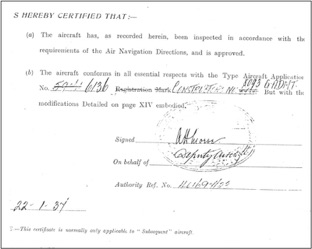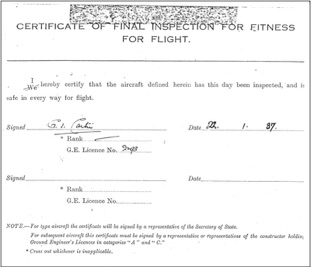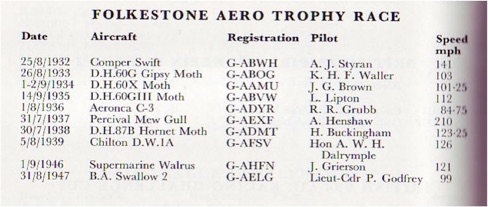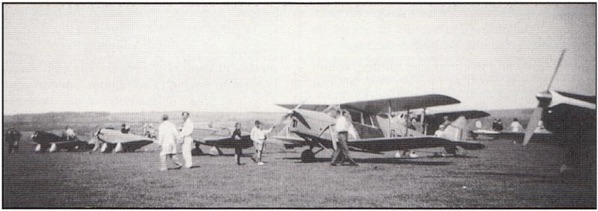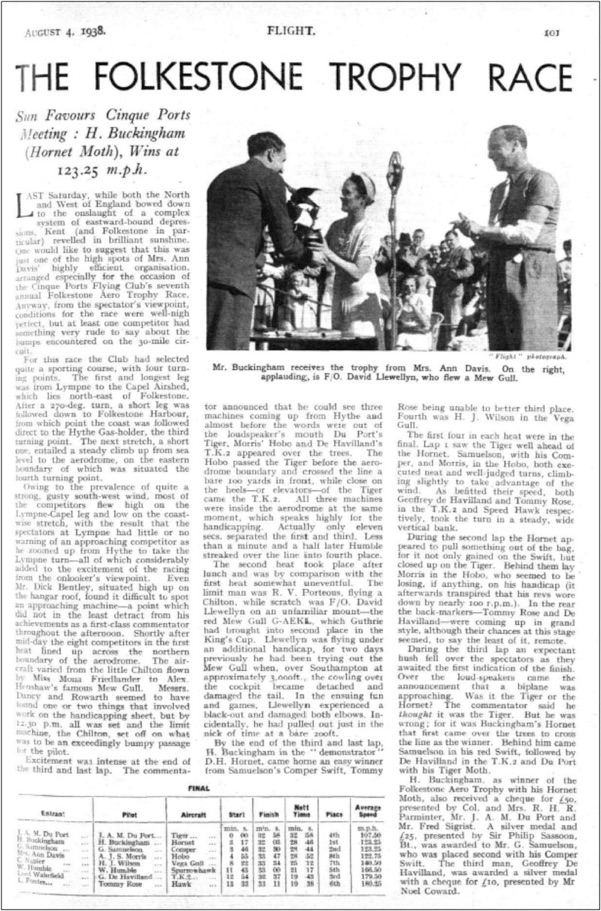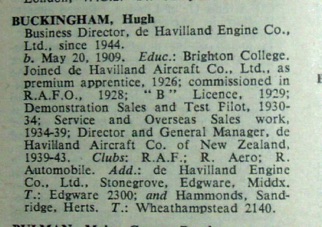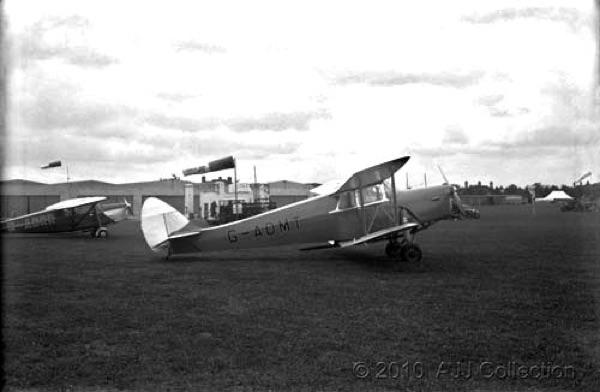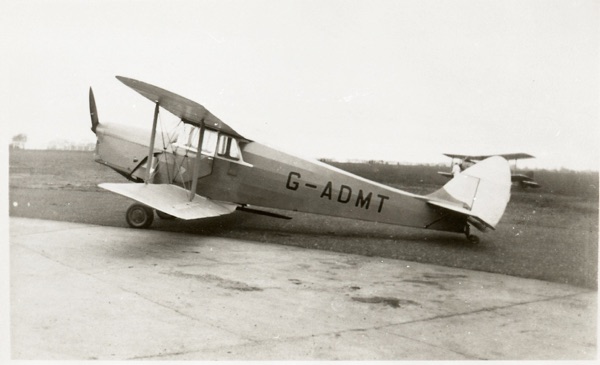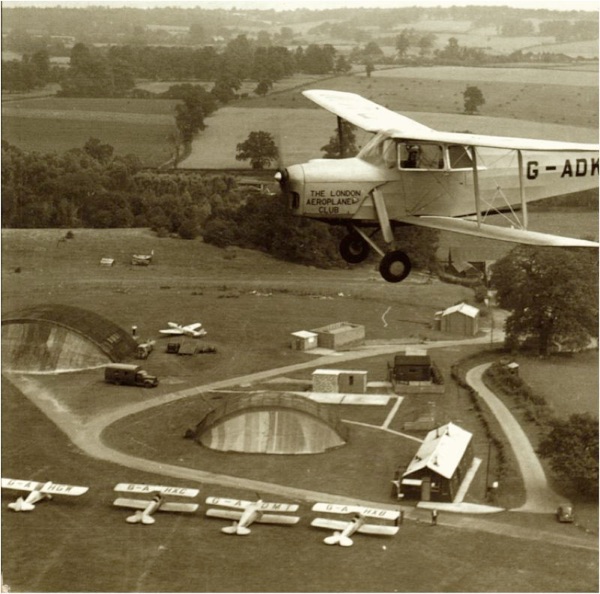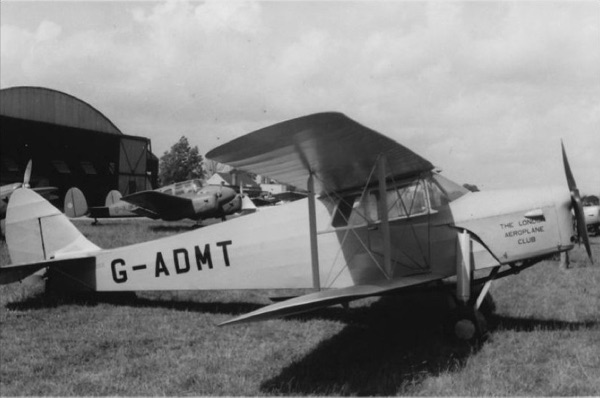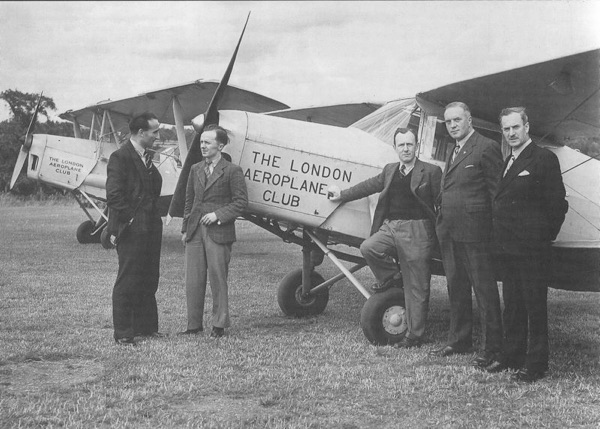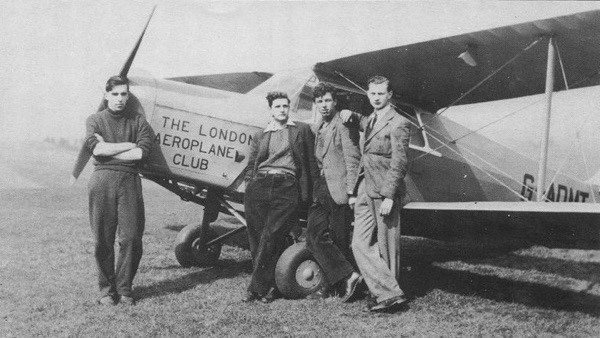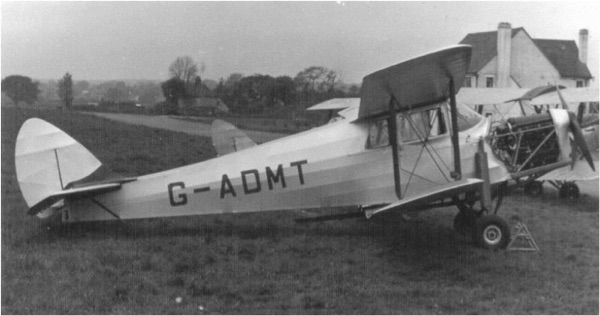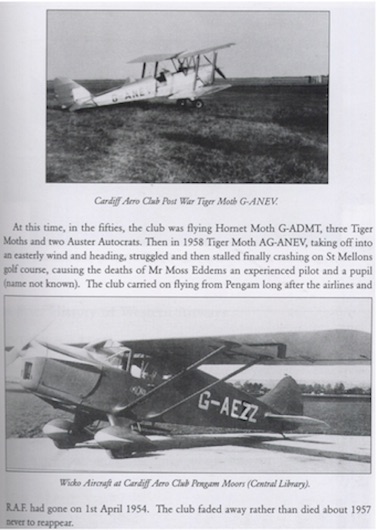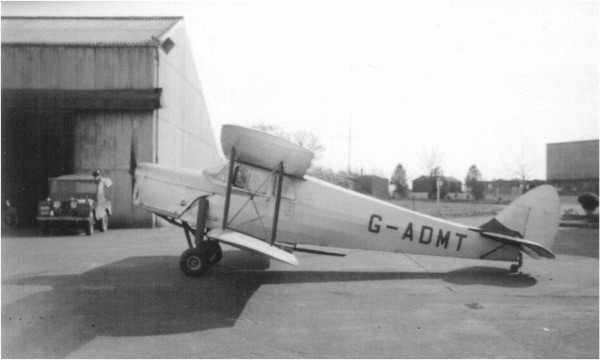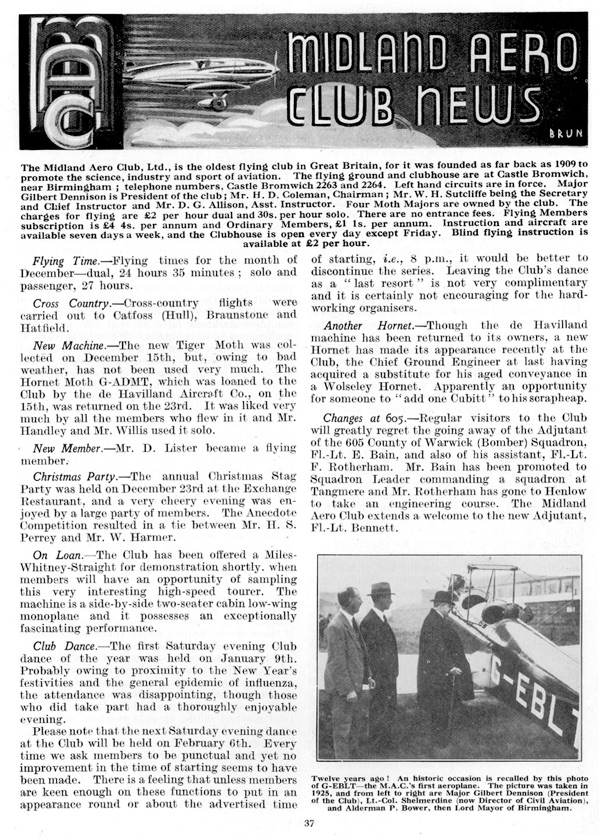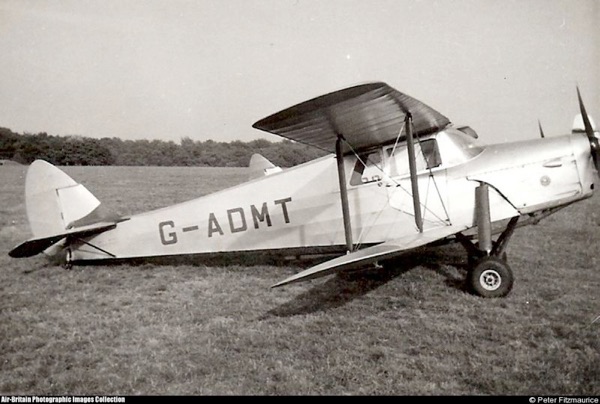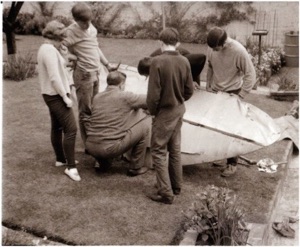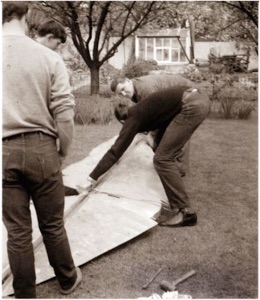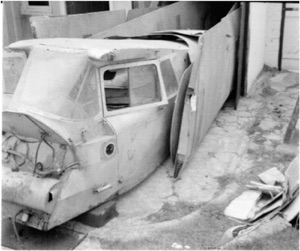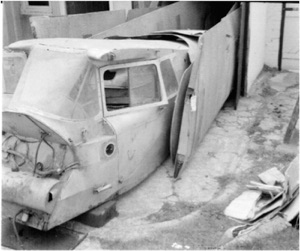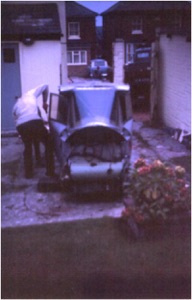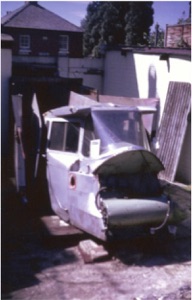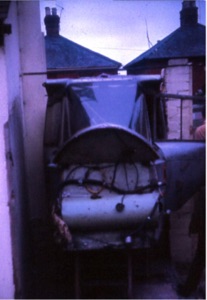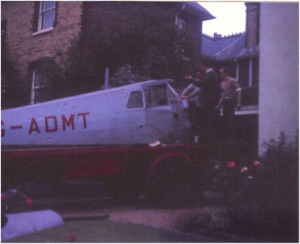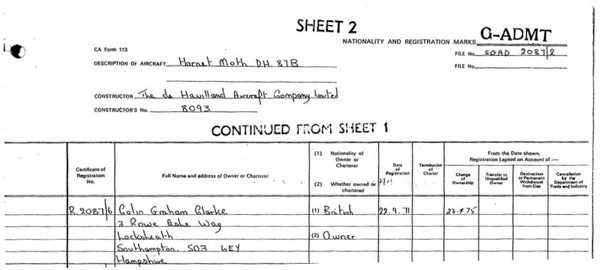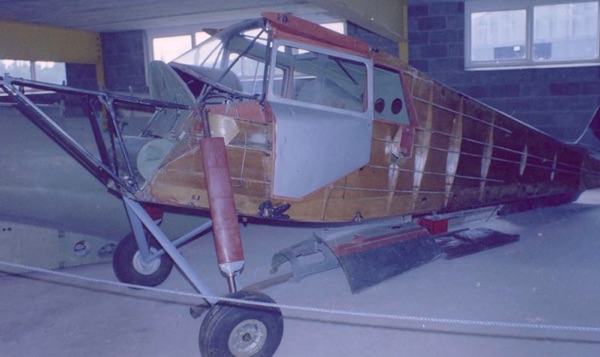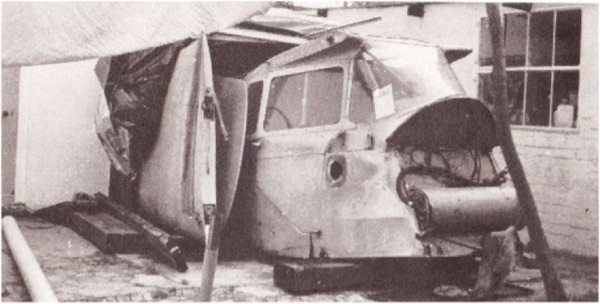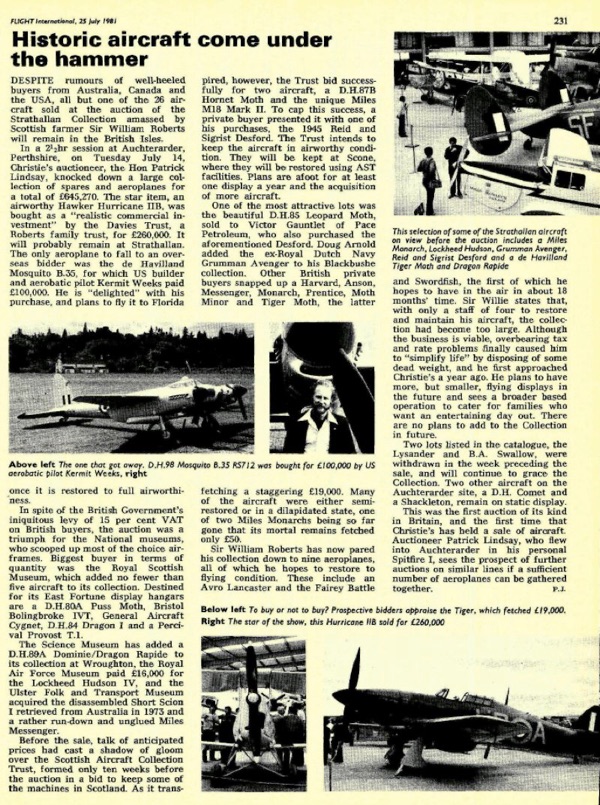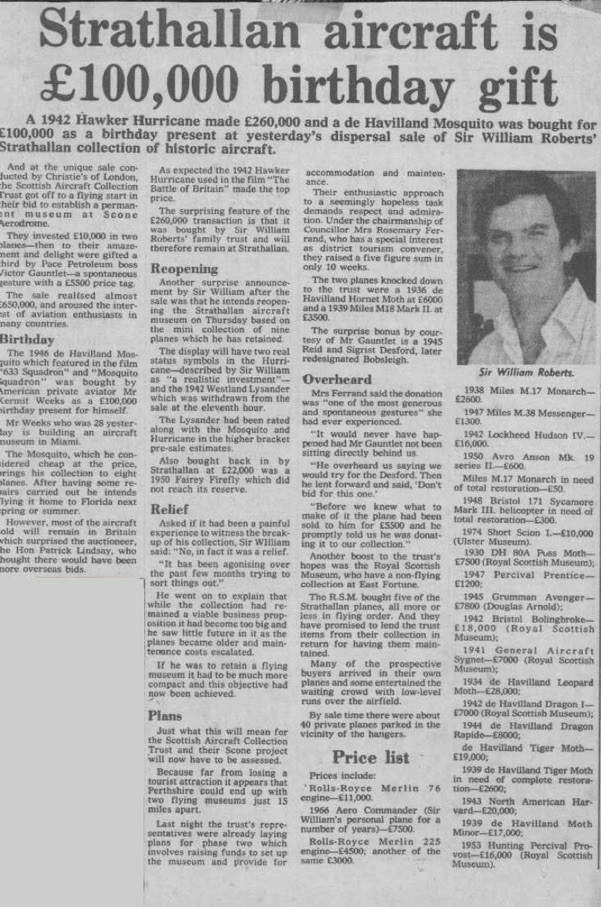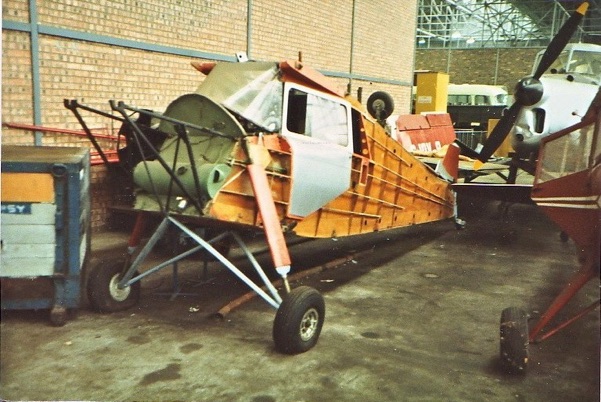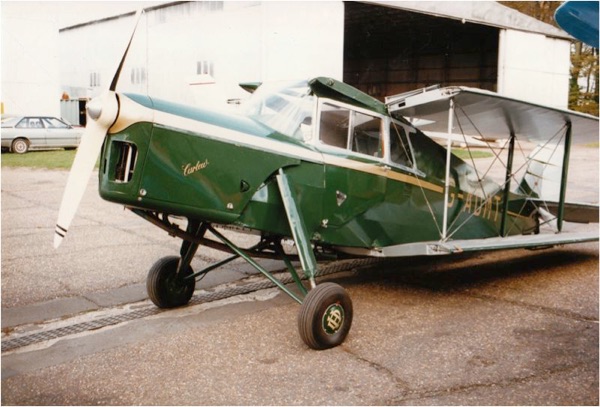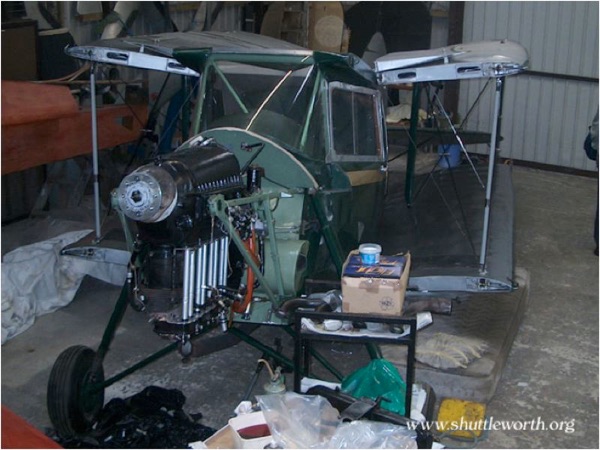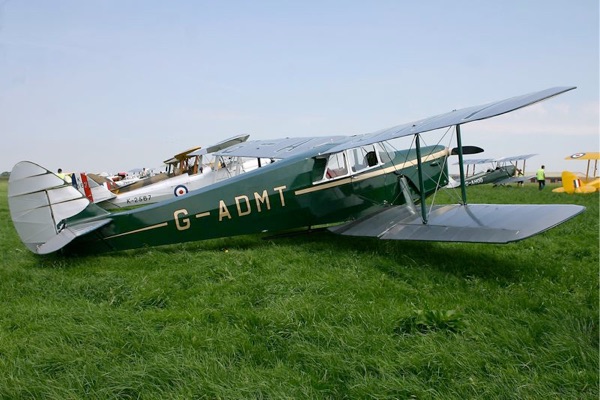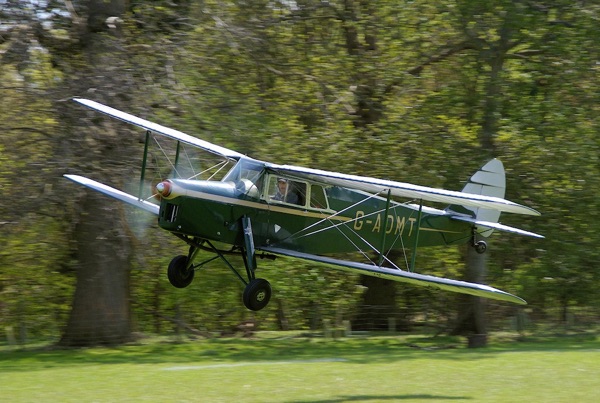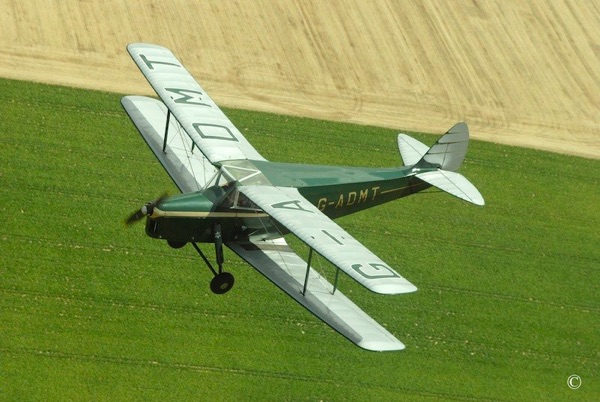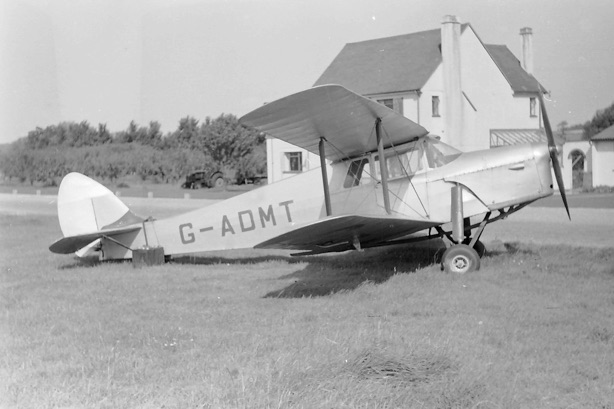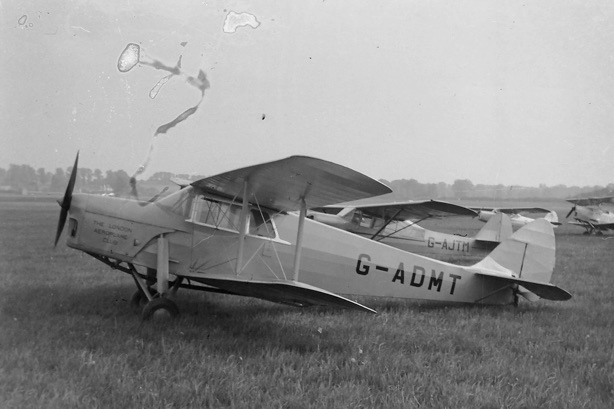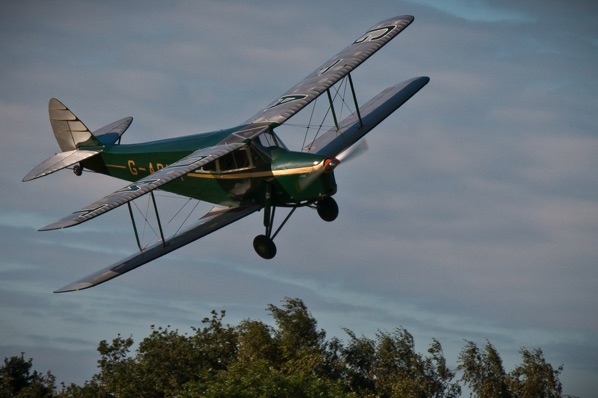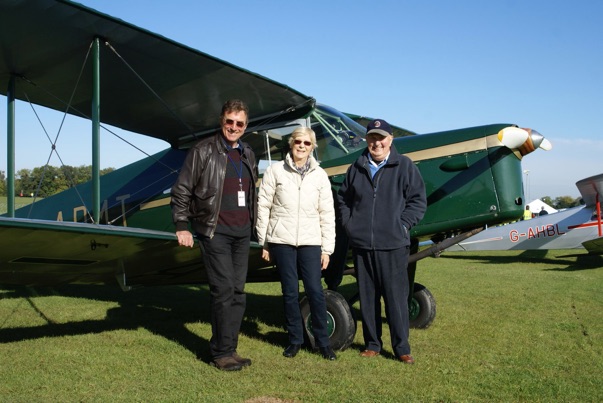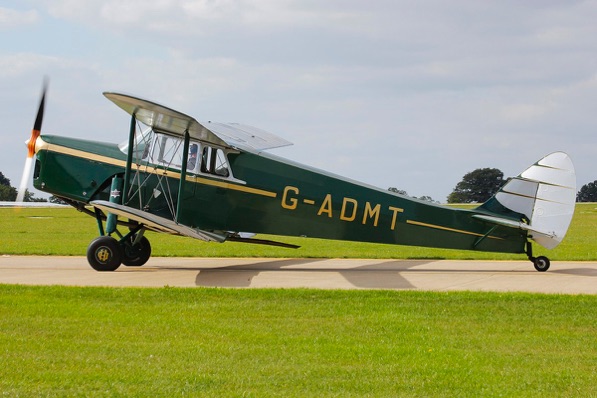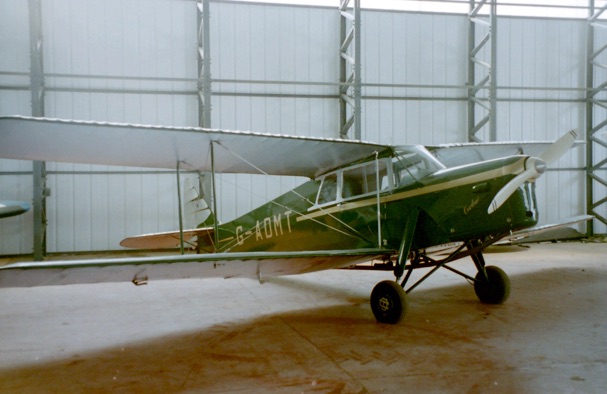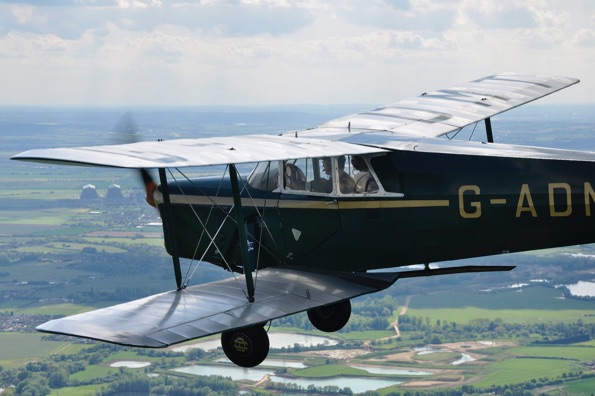The de Havilland DH87 Hornet Moth was designed by Arthur Hagg and the prototype constructed in 1934. The first flight was on 9th May. Two further aircraft were constructed for testing and the first production models, configured with a tapered wing as the DH87A, left the factory in August 1935. The tapered wing was soon replaced with a square wing, which reduced handling problems in roll. A total of 165 were built, numbered 1997 and 8000 to 8163 inclusive, the last given a C of A in October 1938. Of these, some 36 survive, of which about 14 are airworthy around the world; the rest are museum exhibits or wait patiently for a return to the skies.


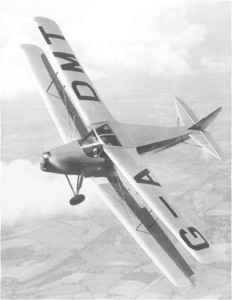
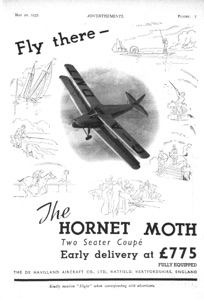
This well-known ‘Flight’ magazine photograph of G-ADMT, taken in July 1936, was used by de Havilland in their advertisements.
(Right: Flight Magazine May 20th 1937)
![The history of No 8093 is as follows:
8th May 1936: G-ADMT was registered to the de Havilland Aircraft Co. Ltd., Hatfield, on Certificate No. 6118. Its first Certificate of Airworthiness, No 5484, was issued on 3rd June 1936. It was used as a test machine for 2,000 lbs MAUW, and also for spinning trials in September 1936. The spinning trials were carried out not by DH, but at Martlesham. To this end an aerobatic seat harness, parachute seats and jettisonable doors were fitted. Ballast was added near the fin to produce an aft CG condition. The conclusion was that the spinning characteristics were acceptable and that trim tab position had no apparent effect on recovery. Later, the aircraft was used as a personal aircraft by Geoffrey de Havilland and as Company hack during WWII from both Hatfield and Witney, when the C of A was extended to 26th June 1940, 26th June 1941, 23rd May 1942, 7th July 1943 and 9th September 1944. The final extension was withdrawn and replaced by Ministry of Aircraft Production (M.A.P) Permit No 3 on 11th October 1943, valid until 10th October 1944 and extended to 31st October 1945.
G-ADMT was one of the only UK-based Hornet Moths to escape impressment into wartime service with the RAF. de Havilland themselves also kept the prototype DH87 G-ACTA until late 1944, and G-ADUR throughout the war. G-AEET was impressed but came back onto the civil register in 1942 for use by de Havilland. 'DMT, 'DUR and 'EET (in Canada) all survive.
… “over the years, he [Geoffrey de Havilland] used all these aeroplanes, as well as the company’s Hornet Moth G-ADMT, for weekend visits to ‘the aeroplane field’ near his old home at Crux Easton where he taxied them into a small fenced enclosure to protect them from farm animals” (A.J. Jackson: de Havilland Aircraft since 1909)
Above: An extract from Captain Geoffrey de Havilland’s logbook (11 July 1933 – 14 August 1952)
Some personal flying logbook entries by Pat Fillingham, the de Havilland test pilot, showed that in 1939, he flew ice accretion tests in the aircraft, picking up 3/8” of ice on the flying wires and leading edges etc. At this time, he had logged only 193 hours total flying…
Below: Extracts from Pat Fillingham’s logbook (10 pages from July 1939 to March 1940):
William Scott-King mentioned in the logbook was granted an Aviator’s Certificate No 8174 at the Henderson Flying School (Royal Aero Club Official Notice to Members in Flight Magazine November 17th, 1927). It would seem likely that he is the individual mentioned and also appearing in the Flight photograph below, left:
G. H. Pike with whom Pat Fillingham flew on the ice accretion trials, went on to test the DH103 Hornet, DH104 Dove, the DH113 Vampire and the DH114 Heron (Above: Flight magazine photo from 11th October 1945)
Factory Paperwork for ‘DMT:
December 1936 G-ADMT was loaned to the Midland Aero Club by de Havilland. The MAC’s ‘Contact’ magazine from which p.37 of the February 1937 issue is reproduced below, had as editor, GS Davison of TT special fame and Bob Holliday (MotorCycle magazine) as Advertisement Manager. Wal Handley was a famous TT rider; Harold Willis was one of the Velocette motorcycle company’s chief designers and a TT rider. This all goes to show what a small world we live in, as the current owner of G-ADMT is a Velocette enthusiast, owning a 350 O.H.C. KTT/KSS and 2 Venoms, one of which was raced until recently.
1938 - A Race Winner:
From Putnam’s ‘British Racing and Record Breaking Aircraft’
Letter in ‘the Moth’ No. 99 of 1997 from Bernard Harding:
“ I took a photograph of a Hornet Moth at Lympne on Saturday July 30th, 1938 on occasion of the Folkestone Aero Trophy Race (above). The Hornet Moth, flow by Hugh Buckingham, won the second heat and also the final. Although it appears in two other photos I took, the registration letters are not readable, and I have long wondered which one it was. I was recently put in touch with John Havers (Air Britain Historian) who managed to come up with the answer that it was G-ADMT…”
Hugh ‘Jimmy’ Buckingham was a test and demonstration pilot working for de Havilland between 1929 and his retirement from de Havilland. He went on to join the Hawker Siddeley Group. The following article was published by Flight magazine 28th March 1958:
Above: G-ADMT at an unknown location between 1938 - 1940; courtesy of the A. J. Jackson Collection at Brooklands Museum
above: at Woolsington airfield, pre-World War Two. (Photograph ref: DPA 2118-221 held at and reproduced here courtesy of Greater Manchester County Record Office)
11th March 1946: Registered to the London Aeroplane Club Ltd., Panshangar. C of A renewed 16th August 1946.
Above: this de Havilland photo from 21st July 1947 shows ‘DKW over Panshangar with ‘DMT on the ground in company with Tigers ‘HXB and ‘HXC with Taylorcraft Plus D, ‘HGW, all part of the London Aero Club's fleet.
Memories of the ‘40s (The Moth No 82, 1993) By Mike Rogers:
“…at that time (Panshangar) it was resplendent in the Club colours – silver wings and tail assembly, yellow fuselage….Flying for students was £1.00 an hour…Closer association with ‘MT came when George Hart (Chief Engineer) assigned me to return for a spell to Salisbury Hall, then still the DH Tech School’s HQ. There, with Bob Woolfenden, ‘ADMT’s fuselage was stripped down for a major overhaul, all carried out in the wooden shed which was the other half of the Tech School Canteen.
I recall that, after removing the fabric, the front end of the lower longerons were found to be badly oil soaked as was one section at the rear which we replaced strictly according to the DH87 Maintenance and Repair Manual procedure. The offending section was cut out and replaced, with butt joins bridged by steel fishplates, bolted through.
At various stages of the work, George Hart would motor over in his pre-War Ford Eight saloon from Panshangar to approve and sign up the work. If the original logbook is still with ‘ADMT, these records should be discernable that work was undertaken in February 1948….”
With the LAC at Panshangar 1947. L to R Alistair Mackenzie, Mike Rogers, Maurice Sibley and Frank Cooper (note windy ASI on the Port top wing, no longer fitted)
July 1947: the photograph was one of a series identifying the handover of the club to the control of the de Havilland Aeronautical Training School. L to R: Mr EJ Mann (DHATS), Flt Lt Dennis Cather (Club CFI), Wg Cdr JA Harris (aerodrome control officer), Wg Cdr Clement A Pike AFC (aerodrome manager Hatfield), and Sqn Ldr Robert W Reeve DFC AFC MM (Principal of the DHATS)
The aircraft was based at Broxbourne for a time between 1946 and 1947 (Wings Over Nazeing 1945-1954, an illustrated history and reminiscences of Broxbourne Aerodrome and the Herts and Essex Aero Club, by Leslie Kimm)
Stapleford in the 1950’s (Tony Clarke Collection courtesy David Whitworth)
White Waltham 14 May 1950 (Tony Clarke Collection courtesy David Whitworth)
4th April 1952: Registered to The Cardiff Aeroplane Club Ltd., Pengam Moors (later Cardiff)
Richard Atkins, Jan 2010: 'My father worked as an engineer with Cambrian Airways at Pengham Moors and use to carry out the checks on the Hornet Moth. When Cambrian moved to Rhoose in 1954, we had catch a train and bus back to Pengham Moors, usually on a Friday night. He also checked out a Tipsy Trainer (G-AFJS), but did not charge them for it. He charged 10 shillings a time to check out the Hornet though!'
from Cardiff Airfields by Ivor Jones:
From an article in The Moth No 126 (2004): Chris and Claire Roberts flew the aircraft to Lundy Island during a 5-day tour of South West, taking in ‘the Saints’ – St Mawgan, St Eval, St Just, St Marys (the Scillies) and St Athan.
Above: at Exeter on 20th March 1955
12th October 1956: Registered to The Herts & Essex Aero Club (1946) Ltd., Stapleford.
17th April 1957: Registered to William J Evans & Sydney S Gilbert trading as The East London Flying Group, Stapleford. C of A lapsed on 27th March 1960.
April 1961: sold and registration cancelled 6th November 1963 as permanently withdrawn from use at Stapleford. It was probably around this time that the original logbooks went missing (telecon John Havers 29.12.09)
Above: at Biggin Hill in 1959
1965: stored at Biggin Hill by Air Couriers Ltd., for use as spares for G-ADND owned by PQ Reiss, who each Monday, flew Andover to Croydon, later Biggin Hill and Gatwick en-route to his office in the City of London, reversing the route on Fridays. PQ Reiss was a well-known character in pre-war sporting aviation and was awarded the Royal Aero Club bronze medal in 1965 to mark over 50 years of aircraft ownership and services to aviation insurance. He owned donated G-ADND to the Shuttleworth Collection at the end of his flying dasy.‘DMT was later moved to Gatwick and stored in the old Gatwick Airport Railway Station building.
1966: Following the demise of Air Couriers (bought by Transglobe Airways July 1967), the dismantled aircraft, without engine, was acquired by Jock Graham (Technical Director) after he had been told to burn it!
4th May 1968: removed from the old Gatwick Airport Railway Station and transported to 2, St. John’s Road, Earlswood, Redhill, Surrey and stored there by John Havers on behalf of Jock Graham and Bill Kelly. To enable the aircraft to be stored at the rear of the house, the fuselage had to be lifted over a 6ft wall. An old coke store provided cover for the rear of the fuselage and part of each wing, the remainder being covered by a plastic sheet normally used for haystacks!
in the care of John Havers, 4th May 1968
in August 1969
4th October 1969: purchased by Cliff Lovell and removed by him on this day. To enable the fuselage to be removed from the garden, part of a wall was removed, which enabled it to pass just between the wall of the house and an upright pillar.
On the lorry:
L: Cliff Lovell
R: Ben Cooper
Control Column Vol. 10 No. 3 March 1976: “A useful addition to any garden shed – G-ADMT when it was owned by John Havers, near Redhill.
‘A long time coming but expected back in the land of the living in the not too distant future. This Hornet was withdrawn at Stapleford in 1963, moved to Biggin Hill, Gatwick and to ‘Air Britain’ Middle East specialist John Havers, for an aborted rebuild and thence to Ron Hayter for spares and, finally, for rebuild again in the Southampton area.’
22nd September 1971: restored to the register in the name of Colin G Clarke, Southampton for rebuild and by 1974 moved to New Milton, Hampshire. However, it was not rebuilt by the time it changed hands again in 1975. Perhaps Mr Clarke decided to sell on before the job was completed.
14th October 1975: Registered to Sir William James Denby Roberts, Trustee of the assets of The Strathallan Aircraft Collection and delivered in January 1976, although still without a Certificate of Airworthiness.
Strathallan – photo by Robert Whitton
She was sold at auction on 14th July 1981 to The Scottish Aircraft Collection Trust Ltd., for £6,000 and roaded to Perth on 8th August 1981. On 9th November the registration was cancelled as withdrawn from use.
1982 The Scottish Aircraft Collection Trust
G-ADMT was listed on the ‘Present Aircraft Collection’ page of a 1982 Appeal for Funds booklet, which had a target of £500,000. Also listed were Miles 18 G-AHKY, the Reid and Sigrist RS4 Desford G-AGOS and G-AOLU, a 1949 Percival P40 Prentice T Mk1. All of these aircraft are recorded on the CAA website as being withdrawn from use and/or de-registered. The booklet indicates that ‘DMT’s engine had 1,016 hours recorded.
At Scone in November 1983 - picture by Alastair Dodds, Principal Curator of Transport, National Museums of Scotland
December 1984: roaded to Hamble and registered 14th August 1986 to Michele A Livett (Robin Livett’s daughter), Sywell. To Cliff Lovell, Hampshire Lightplane Services Ltd, Walkeridge Farm, Overton, Hampshire for rebuild in late 1986; later it was moved to Combe Bissett. The aircraft was re-flown in August 1990 and C of A renewed 14th August 1990; it was named “Curlew” - based at Booker, and later at White Waltham.
At Booker in about June 1989 (photo from Paul Herbert, who worked for Robin Livett’s Central Stores at White Waltham – Paul’s Audi in the background)
Paul Herbert: “I worked for Central Stores Ltd (Robin distributors) at White Waltham 1988 – 89. The Hornet spent its time between White Waltham and Booker (maintained by PPS), flown by Robin Livett & John Parks (both Directors of CSL). I spent many happy evenings in it around the local area until Central Stores went bust; I believe Robin Livett used the Hornet to commute between White Waltham and Dijon (Robin factory) & his French property, …I remember it had the name "Curlew" painted on the cowlings.”
12th August 1993: registered to Memorex Telex (UK) Ltd., Wokingham. C of A lapsed 13th August 1993
A collection of aircraft was offered for sale by tender in late summer of 1993 by Bill Fisher of F and H (Aircraft) Ltd at the time the collection consisted of Sea Fury, Sea Vixen, Pilatus P2, the Hornet Moth, Chipmunk, PA28 and Vampire; there was talk of the FW189 joining the collection, however it all ground to a halt before the deal was completed.
24th February 1994: registered to Aces High Ltd., North Weald with C of A renewed 15th November 1994. The aircraft had been hangared at North Weald in flyable condition together with a Vampire, Tiger Moth, Sea Fury and others. A forum contributor stated on 31st December 2009 that “I saw DMT in pristine condition in Aces High hangar at North Weald on 19th July 1994 she was beautifully finished in dark green-silver- & gold”
June 1994: At North Weald in the care of Aces High (photo: Michael O’Sullivan)
15th November 1994: The CAA accepts that the original logbooks are 'lost/destroyed/no longer available. The replacement logbooks constitute an accurate record based on the evidence available and is acceptable to the Authority.' They deem the airframe hours to be 3,150 and engine hours to be 1,066 hrs. New logbooks start from this date.
1st February 1995: registered to David G Ross & Patrick A de Courcy Swoffer, White Waltham. Photos taken at Lasham and Woburn Abbey show “Curlew” still painted on the engine cowlings. Hours flown during this period: 60.35
5th September 1995: David Ross sells his share and the aircraft is registered to Pat Swoffer, White Waltham, later at Lasham and Popham. Hours flown during this period: 305.50. Pat advertised the aircraft for sale in 2002 in issue 119 of ‘The Moth’ magazine: “hangared at Popham, in excellent condition and fitted with Becker radio and VOR.”
3rd February 2004: registered to Steven & Helen Roberts, Kemble and later Oaksey Park. Hours flown during this period: 83.00. Work completed during Steve’s ownership included the replacement of the upper wing pin attachment brackets by Skysport Engineering at Sandy in Bedfordshire.
9th July 2005 at Skysport’s hangar near Old Warden.
2006 at Dunkeswell
25th November 2008: registered to Dave Reid and flown regularly from Felthorpe Airfield, near Norwich.
25th July 2009 en route to St Quentin during the DH Moth Club Tour de France
August 2009 at Felthorpe (photo: www.cameophotographic.co.uk)
9th May 2010 at Henham Park, Suffolk. (Photo © Phil Walley)
28th August 2010 at Great Oakley in Essex: the man who rebuilt the aeroplane 20 years before, Cliff Lovell, who arrived in his immaculate 1941 Luscombe, G-BTCJ. (Photo: Dave Reid)
Felthorpe 8th August 2011 (Photo by Simon Smith)
Current and former owners Dave Reid, Mrs & Mr Robin Livett at Old Warden during the de Havilland Moth Club’s last ever Charity Flying weekend 14th October 2012 (Photo by Paul Dubois)
Hold for departure, LAA Rally Sywell, 31st August 2013 (Photo by Brian Nicholas)
With 11 out of the 12 airworthy Hornet Moths in the UK and the crews at Sywell on 6th May 2014 for the ‘Hornet Swarm’, celebrating the 80th anniversary of the first DH87a flight. (Photo by David Whitworth)
Air to air photography on 15th May 2014 by Geoff Collins, in his Piper Cub flown by Desmond Penrose. Note the Cardington airship sheds in the background.
Publications
Civil Aircraft Markings 1954 by JWR Taylor (correct to April 1, 1954) pub. Ian Allan Ltd. Owned by the Cardiff Aeroplane Club (with photo - see above)
Aeroplane Apr-02: Database of all DH87 production; type history; seaplane; technical description; military versions
Wingspan Nov-92: Description
Pilot Apr-96: 5-page article on G-ADMT
Flyer Sep-04: Photo of G-ADMT - as intro to unrelated maintenance article
Pilot Aug-08: Photo of G-ADMT - featured as 'a gentle display' at Kemble, 'after the jets'.
Control Column: Mar-76 Brief histories of surviving Hornets (as above).
The Moth/Enterprise No 61: page 3 (Autumn 1986) ‘Robin Livett's Hornet Moth G-ADMT has moved into the Hannington workshops for complete restoration.’ Also p23. an interesting letter re seat belt manufacture recommendation
The Moth/Enterprise No 75: page 19
The Moth/Enterprise No 77: inside rear cover (Summer 1991) 2 photos, cockpit and formation shot.
The Moth/Enterprise No 81: page 10
The Moth/Enterprise No 82: page 2, (1993) 'DMT is being advertised by owner Robin Livett. This DH87B has only a few hours on her since complete restoration three years ago, and is currently hangared at White Waltham.' p. 22/23 'Memories of 'MT', an article by Mike Rogers.
The Moth/Enterprise No 90: page 4 (1995) p.4 ‘…Pat Swoffer and David Ross acquired Hornet Moth G-ADMT at auction… in recent years G-ADMT has led an interesting but pedestrian life, getting caught up in an alleged international swindle which resulted in her eventual sale along with a small fleet of other more powerful beasts. If anyone knows the whereabouts of logbooks and documents pertaining to the most recent history of G-ADNT, the new owners would be glad to recover them.’
The Moth/Enterprise No 91: page 27 (Autumn 1995) pictured at Woburn (flown in by Pat Swoffer).
The Moth/Enterprise No 93: page 7 David Ross has sold his half share in G-ADMT to co-owner Pat Swoffer p.16 July 1947 photo at Panshanger.
The Moth/Enterprise No 94: page 3; also page 8 article on Hornet Moth undercarriages.
The Moth/Enterprise No 99: page 26 & 27 (1997) Photos taken at Oaksey Park in 1996 and at Lympne in 1938.
The Moth/Enterprise No 103: page 19 (1998) Article and photo which mentions G-ADMT in the early days at Crux Easton; p.21 Photo of Pat Swoffer landing at Woburn; page 24 listed as Woburn visitor.
The Moth/Enterprise No 119: page 40 (2002) Advertised for sale.
The Moth/Enterprise No 124: page 44 (Nov 2003) Picture of DMT at Woburn, ‘owned by Pat Swoffer, flown in by Steve Bohill-Smith,’ the ac noted as being currently for sale; page 72 advertised as Excellent condition. ‘Full CofA expires May 2004. Becker 729 channel radio and VOR. David Clarke Intercom. Garmin hand held GPS, removable. Many valuable spares including immaculate propellor and impulse magneto. Very rare original Manual of Instruction for Operation, Maintenance, Rigging and Repair of the Hornet Moth Type DH87A amended to 87B. Hangared at Popham’.
The Moth/Enterprise No 126: page 6 (Apr 2004) Steve Roberts acquires the aircraft, delivered to Kemble from Popham by Steve and Pete Thorn; pages 20/21 Article by Chris Roberts, flying DMT from Cardiff to Lundy Island.
The Moth/Enterprise No 145: page 5 & 6 (2008) DCR acquires the aircraft
The Moth/Enterprise No 147: page 42 photo of DMT at the Henlow Flying Forum
The Moth/Enterprise No 148: page 24 photo of DMT - Tour de France 2009
The Moth/Enterprise No 150: in the background of a photo of ‘DKL in France
The Moth/Enterprise No 151: several photos
The Moth/Enterprise No 152: page 29 a sketch and description of DMT at Crux Easton; page 25 a photo of DMT with wings folded
‘Moths in Detail’ 2010 by Stuart MacKay - spinning trials for the DH87
‘General Aviation’ Feb 2011 journal of AOPA - 3 page article on Hornet Moths, with a picture of DMT from 1936
The Moth/Enterprise No 155: page 38, participant in the 2011 Vintage Air Tour. Page 40 Belvoir Castle International Moth Rally 2011. Page 63 photo of departure from Belvoir.
Light Aviation Aug 2012: page 47, picture of the aircraft at the LAA Rally in 2011
The Moth/Enterprise No 160 December 2012: page 31, participant in the last dHMC Charity Air Day. Page 38 photo of DCR/’DMT and former owners Robin and Josie Livett.
Light Aviation, November 2013: Page 40, picture of the aircraft arriving at the LAA Rally in 2013
Light Aviation, February 2014: Page 13, photo of the aircraft with other DH types based at Felthorpe.
The Moth/Enterprise No 166 June 2014: Centre spread article about the Hornet Swarm at Sywell, when 11 out of 12 airworthy Hornets gathered to celebrate the 80th anniversary of the first flight of the Hornet Moth.
Suffolk & Norfolk Life magazine June 2014: Article about Northrepps airfield with a picture of the aircraft departing.
Links
The de Havilland Moth Club
The A.J. Jackson Collection
The Shuttleworth Collection
Flight International Archive](G-ADMT_files/shapeimage_2.png)





